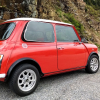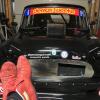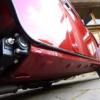The odometer is what you need to be going off to judge the accuracy first.
The Odo and needle movement are usually operated by different mechanisms. Usually mechanical speedo needles move against a coiled spring, forced by magnetic fields from a rotating disk attached physically to the speedo cable. The video I linked described this system better. Odo is just driven by direct gearing off the cable rotation.So it is possible to have needle movement not sync'd/calibrated to odo.
Now it may be the Nippon speedo I have on the car now is not as described and uses a different movement mechanism.Never seen one apart to know for sure.
Sorry, I haven't looked at the video above (15 mins is a little more than I feel I can sit through right now !) so I don't know if this is covered in the video.
First order of business here, I find, is as Ethal suggests, get the Odometer right by changing out the drive gears in the gearbox (if you can), This is important as it then puts the Speedo Head in the right ball Park from were it can usually be adjusted from.
I know on the Smith's unit (maybe on the Japanese units too), if you remove the Needle and the Face Plate, there's an Adjustment Screw that raises or lowers the Armature in relation to the Magnet that you mentioned further up. It's only a very small screw and doesn't need big movements to make adjustments, so go easy here. It only has a small range (about 10 to 15%), but unlike moving the Needle, this keeps it in Calibration across the whole scale.
Again, on the Smiths units, and I'm not sure on the Nippons, there are 2 very small dots on the face just down past (lower) than zero and the stop here. When refitting the Needle, it should be aligned between these marks, to provide the correct preload on the hair spring.
It's been a little while since I've done these, I moved on to an Electronic Speedo about 8 years ago and haven't looked back. Changing Tyres sizes or Final Drive Ratios, it's very easy and quick to just punch in some new numbers and off you go.

















